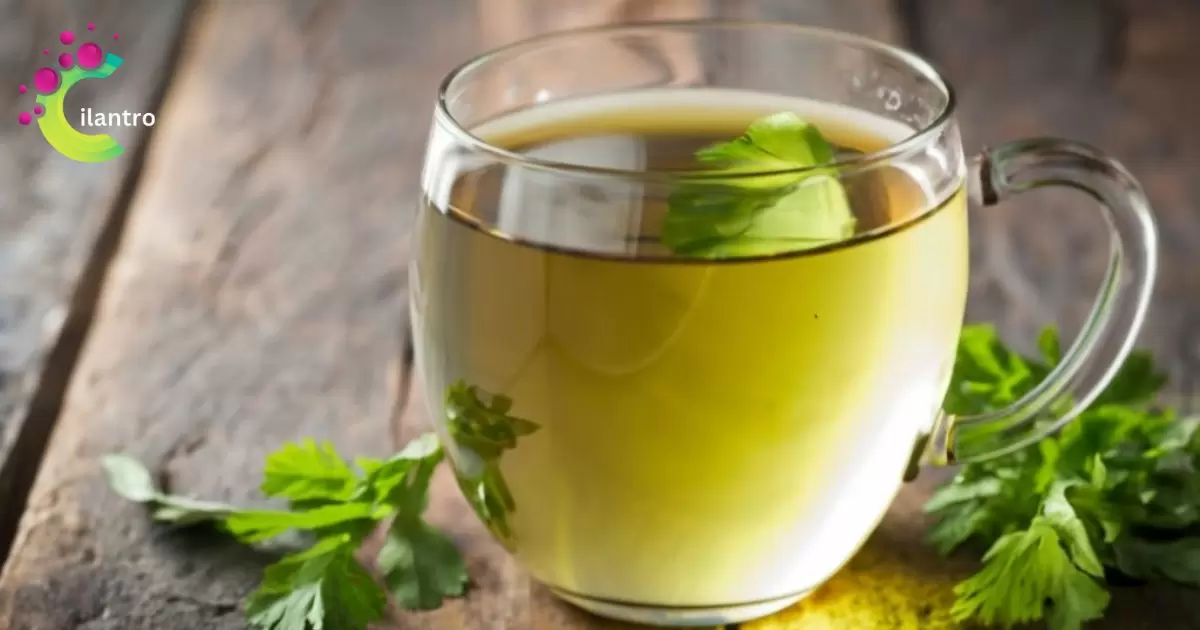Cilantro tea is not only a delightful and refreshing beverage but also boasts numerous health benefits.
This aromatic herb, also known as coriander in many parts of the world, is rich in antioxidants, vitamins, and minerals. The question is here, how to make cilantro tea? It is very easy and simple to make. To make cilantro tea, boil water and add fresh cilantro leaves. Let it steep for 5-10 minutes. Strain the tea and add honey or lemon for flavor. Enjoy the refreshing taste and potential health benefits of cilantro tea.
Make cilantro tea at home is a simple process that allows you to enjoy both the taste and potential health perks of this herbal infusion. Elevate your tea experience with the unique and invigorating taste of cilantro.
In this article, we discuss more healthful and interesting things, so stay tuned with us!
What is Cilantro?

Cilantro is a leafy herb commonly used in cooking. It has a fresh, citrusy flavor and is often found in salads, salsas, and Asian dishes. People use it in various cuisines, like Mexican, Indian, and Thai, to add a distinctive taste.
Some love its citrusy, herbaceous notes, while others find its taste polarizing, as it can be described as soapy to some individuals. In some places, cilantro is also known as coriander leaves, and both the leaves and seeds of the plant are used in various culinary applications.
Parrots eat cilantro, and overall, cilantro is a versatile herb that adds a unique touch to many dishes around the world.
Historical Significance
Cilantro, scientifically known as Coriandrum sativum, has been used for centuries in various cuisines and traditional medicine. Its roots can be traced back to ancient civilizations, including those of the Mediterranean, Middle East, and Asia.
In Ayurveda, the traditional medicine system of India, cilantro has been valued for its digestive and detoxifying properties.
The Origins and Cultural Significance of Cilantro Tea
Cilantro, also known as coriander in some regions, has a rich history dating back thousands of years. Its usage can be traced to ancient civilizations, where it was valued not only for its culinary applications but also for its potential medicinal properties.
Explore the historical roots of cilantro tea and its cultural significance across different regions.
The Health Benefits of Cilantro Tea
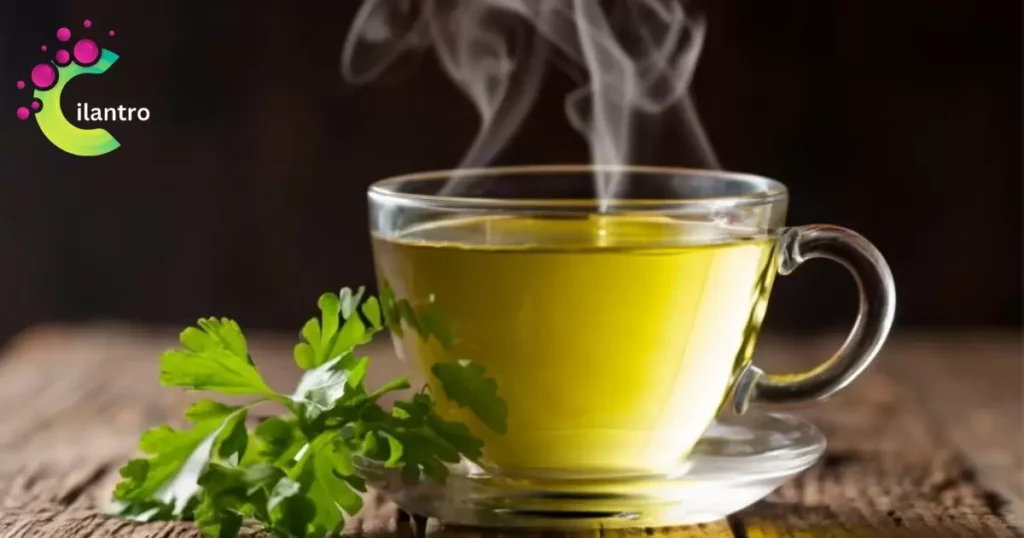
Before diving into the recipe, let’s explore some of the health benefits associated with cilantro tea:
Rich in Antioxidants
Cilantro is packed with antioxidants that help combat oxidative stress in the body, potentially reducing the risk of chronic diseases.
Aids Digestion
Cilantro has been traditionally used to alleviate digestive issues. Drinking cilantro tea may help soothe the digestive system and alleviate bloating.
Detoxification
Cilantro is believed to aid in the removal of heavy metals from the body. This property makes cilantro tea a popular choice for those looking to detoxify.
Rich in Vitamins and Minerals
Cilantro is a good source of vitamins A, C, and K, as well as minerals such as potassium and manganese.
Now, let’s move on to the step-by-step guide on how to make cilantro tea.
Making Your Own Cilantro Tea
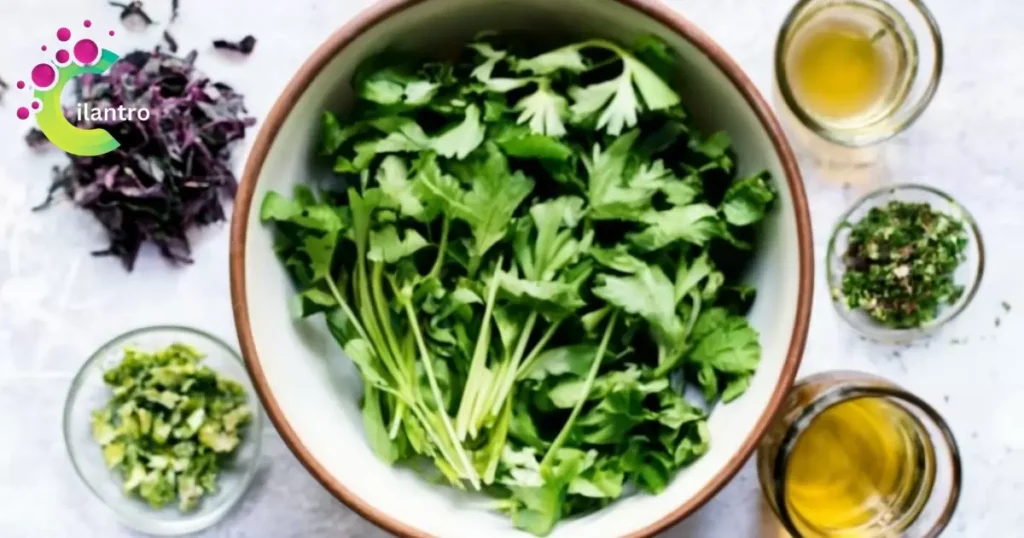
Making your own cilantro tea is simple. Cilantro tea is rich in antioxidants that support overall health. It aids digestion and can relieve bloating and indigestion.
The tea also contains vitamins and minerals, promoting a strong immune system. Enjoying cilantro tea regularly can be a tasty way to boost your well-being.
Simple Ingredients
- 1 bunch of fresh cilantro (coriander)
- 4 cups of water
- Optional: honey or lemon for added flavor
Instructions
Select Fresh Cilantro
Choose a fresh bunch of cilantro with vibrant green leaves. Ensure that it is clean and free from any dirt.
Rinse Thoroughly
Wash the cilantro under running water to remove any impurities. Pat it dry with a clean kitchen towel.
Prepare the Leaves
Separate the cilantro leaves from the stems. You can use both leaves and stems, but some people prefer using only the leaves for a milder flavor.
Boil Water: Bring 4 cups of water to a boil in a pot or kettle.
Add Cilantro: Once the water is boiling, add the cilantro leaves to the pot. Let it simmer for about 5-7 minutes. This allows the flavors to infuse the water.
Strain the Tea: After simmering, use a strainer to separate the cilantro leaves from the tea. Discard the leaves.
Optional Additions: If desired, add honey or a squeeze of lemon to enhance the flavor of your cilantro tea.
Serve and enjoy: Pour the cilantro tea into cups and savor the refreshing taste. You can enjoy it hot or let it cool for an iced version.
How to make Cilantro Tea for Weight Loss

- Boil water in a pot.
- Rinse a handful of fresh cilantro leaves.
- Add the cilantro and ginger to the boiling water.
- Let it simmer for 5-7 minutes.
- Strain the tea to remove leaves.
- Pour the tea into a cup.
- Optionally, add a bit of honey for sweetness.
- Sip the cilantro tea slowly.
- Drink it before meals for weight loss benefits.
Enjoy this natural and healthy way to support weight loss
Variations of Cilantro Tea
Cilantro tea comes in different variations, each offering a unique taste and potential health benefits. Experimenting with these variations allows tea enthusiasts to discover their preferred blend of cilantro tea.
Cilantro and Mint Tea
For an extra burst of freshness, consider adding mint leaves to your cilantro tea. Mint complements the citrusy and earthy notes of cilantro, creating a delightful blend.
Cilantro-Lemon Tea
Enhance the flavor profile by adding lemon zest or a slice of lemon to your cilantro tea. The citrusy notes add a zingy twist, making the tea even more invigorating.
Spiced Cilantro Tea
Experiment with spices like ginger or cinnamon for a spiced version of cilantro tea. These additions not only contribute to the flavor but also bring their own set of health benefits.
Pairing Cilantro With Other Herbs
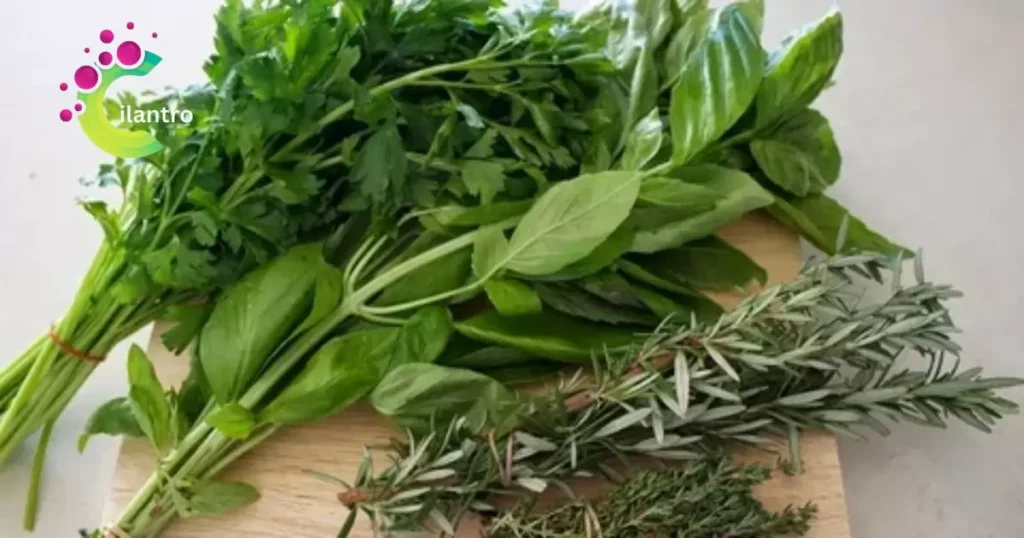
Cilantro’s unique flavor can be enhanced by pairing it with other herbs.
Complementing Flavors
Combine cilantro with parsley for a fresh and balanced herb blend. Mint adds a cool and refreshing note to cilantro, creating a dynamic duo.
Ethnic Fusion
Get creative with cilantro and cilantro in Mexican dishes for an authentic touch. Pair cilantro with basil to create a fusion of flavors in Italian or Mediterranean recipes.
Culinary Harmony
Balance the boldness of cilantro with the mildness of chives for a harmonious blend. Create a zesty mix by combining cilantro with dill for a lively culinary experience.
Tasty Garnishes
Use a cilantro and tarragon combo as a flavorful garnish for soups, salads, and main dishes. Cilantro and thyme can elevate the taste of roasted or grilled meats and vegetables.
Final Tips
Experiment with different herb pairings to discover your preferred flavor combinations. Be mindful of the intensity of each herb to ensure a well-balanced and delightful dish.
Cilantro Tea for Relaxation
Cilantro tea is not just about its refreshing taste; it can also serve as a soothing beverage to unwind after a long day.
Consider incorporating it into your evening routine, perhaps paired with a good book or during a quiet moment of reflection.
Cilantro Tea and Culinary Uses
Beyond being a beverage, cilantro tea can be used in cooking. The leftover strained cilantro leaves can be added to salads, soups, or used as a garnish to infuse dishes with a subtle herbal flavor.
Potential Side Effects and Precautions
While cilantro tea is generally safe for most people, it’s essential to be aware of potential side effects:
Allergies
Some individuals may be allergic to cilantro. If you experience any allergic reactions, such as itching, swelling, or difficulty breathing, discontinue consumption and seek medical attention.
Pregnancy
Pregnant women should consume cilantro in moderation, as excessive amounts may stimulate uterine contractions.
Medication Interactions
If you are taking medications that cilantro might interact with, such as blood thinners, consult with your healthcare provider before regularly consuming cilantro tea.
Cilantro Tea Recipes for Different Purposes

Cilantro tea can be adapted to suit various preferences and health goals. Explore specific recipes tailored for different purposes, such as promoting digestion, boosting immunity, or providing relaxation.
Highlight variations in ingredient ratios or additional herbs and spices that can be incorporated to customize cilantro tea for specific needs.
Refreshing Cilantro Tea
- Boil water and add fresh cilantro leaves.
- Let it steep for 5-7 minutes.
- Strain and enjoy a revitalizing cup for a burst of energy.
Digestive Aid Cilantro Tea
- Combine cilantro and ginger in hot water.
- Allow it to steep for 10 minutes.
- Sip this tea after meals to promote digestion.
Relaxing Cilantro and Chamomile Tea
- Mix cilantro and chamomile flowers in hot water.
- Steep for 15 minutes for a calming blend.
- Ideal for winding down before bedtime.
Immunity-Boosting Cilantro Lemon Tea
- Infuse cilantro and lemon slices in hot water.
- Steep for 8-10 minutes to extract flavors.
- Strengthen your immune system with this vitamin-rich tea.
How to Make Store-Bought Dried Cilantro Tea?
Here’s a table with 10 points on how to make store-bought dried cilantro tea:
| # | Step | Description |
| 1 | Purchase dried cilantro from a store | Buy high-quality, store-bought dried cilantro from a reputable source. |
| 2 | Measure the cilantro | Use a teaspoon or tablespoon to measure the desired amount of cilantro. |
| 3 | Boil water | Bring water to a boil in a kettle or on the stovetop. |
| 4 | Use a teapot or infuser | Place the measured dried cilantro in a teapot or tea infuser. |
| 5 | Pour hot water over cilantro | Pour the boiling water over the dried cilantro in the teapot or infuser. |
| 6 | Steep for 5-10 minutes | Allow the cilantro to steep in the hot water for 5 to 10 minutes. |
| 7 | Strain the tea | If you used loose cilantro, strain the tea to remove the leaves. |
| 8 | Optional: Add sweetener or lemon | Enhance the flavor by adding honey, sugar, or a squeeze of lemon. |
| 9 | Adjust to taste | Taste the tea and adjust the sweetness or acidity according to your liking. |
| 10 | Enjoy your cilantro tea! | Pour the tea into a cup and savor the unique flavor of cilantro. |
Remember to experiment with the quantities and steeping time to find the perfect balance for your taste preferences.
Heavy Metal Detoxification Mechanisms
Explore the biochemical processes by which cilantro may facilitate the removal of heavy metals from the body. Investigate the compounds present in cilantro that contribute to its chelating properties.
Understanding the mechanisms behind cilantro’s detoxifying effects adds a scientific perspective to its traditional uses.
Cilantro Tea: An Eco-Friendly Perspective
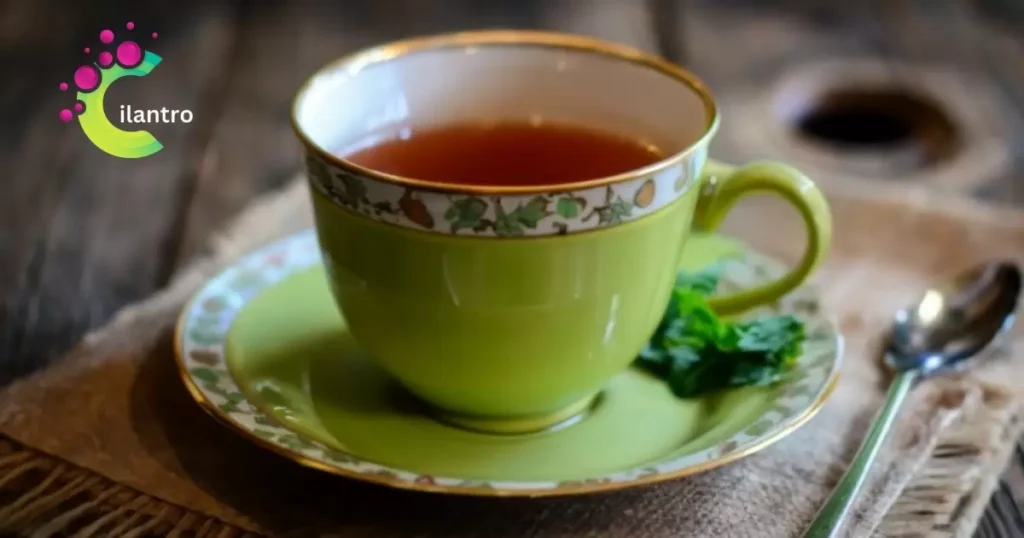
Highlight the sustainability aspect of using cilantro in tea. Discuss how cilantro is a fast-growing herb that requires minimal resources, making it an eco-friendly choice compared to some other herbal teas.
Explore the environmental benefits associated with cultivating and consuming cilantro.
Growing Your Own Cilantro
Provide tips on cultivating cilantro at home, emphasizing its low maintenance and quick growth. Encourage readers to consider growing their own cilantro as a sustainable and cost-effective way to enjoy fresh leaves for tea.
Cilantro Tea and Its Detoxifying Properties
Cilantro is often celebrated for its potential to aid in detoxification. Delve into the science behind cilantro’s ability to bind to heavy metals and toxins in the body.
Explore studies or anecdotal evidence supporting the detoxifying properties of cilantro, shedding light on why this herb has become a popular choice for those seeking to cleanse their systems.
Immunity-Boosting Infusion
Explore a cilantro tea recipe enriched with immune-boosting ingredients like turmeric or echinacea. Discuss how the combination of these herbs can contribute to strengthening the immune system.
FAQ’s
Can you boil cilantro and drink it?
Yes, you can boil cilantro and drink it as an herbal infusion.
Does cilantro make a good tea?
Cilantro is not typically used for tea due to its strong flavor, but some people may enjoy it in herbal blends for its potential health.
What organ is cilantro good for?
Cilantro is good for supporting liver health.
Is it OK to eat cilantro daily?
It is generally safe to eat cilantro daily as part of a balanced diet.
What are the benefits and side effects of cilantro tea?
The benefits of cilantro tea may include aiding digestion and providing antioxidants. However, some may experience allergic reactions or dislike its taste.
Conclusion
Cilantro, also known as coriander, is a versatile herb widely used in global cuisines, including Mexican, Indian, and Thai dishes. Some appreciate its citrusy, herbaceous flavor, while others find it divisive, describing it as soapy. Scientifically named Coriandrum sativum, cilantro has a rich history, dating back to ancient Mediterranean, Middle Eastern, and Asian civilizations. In Ayurveda, it’s valued for digestive benefits.
Cilantro tea, with its rich antioxidant content, aids digestion, relieves bloating, and supports overall health. Packed with vitamins A, C, and K, as well as minerals, cilantro contributes to a robust immune system. For those curious about incorporating cilantro into their routine, learning how to make cilantro tea? is simple boil water, add fresh cilantro leaves, simmer, strain, and optionally add honey or lemon.
Variations like cilantro-mint or cilantro-lemon tea offer diverse tastes and potential health benefits. Cilantro tea isn’t just a beverage; it can be used in cooking and adapted for specific purposes, such as digestion, relaxation, or immunity.
Despite its benefits, cilantro tea may have side effects for some, including allergies and potential interactions with medications. Pregnant women should consume it in moderation. Cilantro’s sustainable growth and minimal resource requirements make it an eco-friendly tea choice. Experiment with cilantro tea recipes and explore its detoxifying properties, shedding light on why it’s a popular choice for cleansing.

Meet our website’s admin, a culinary enthusiast dedicated to curating delectable food ideas. With a passion for gastronomy, they expertly craft and present a diverse array of recipes, tips, and inspirations, making our platform a go-to destination for culinary creativity.
